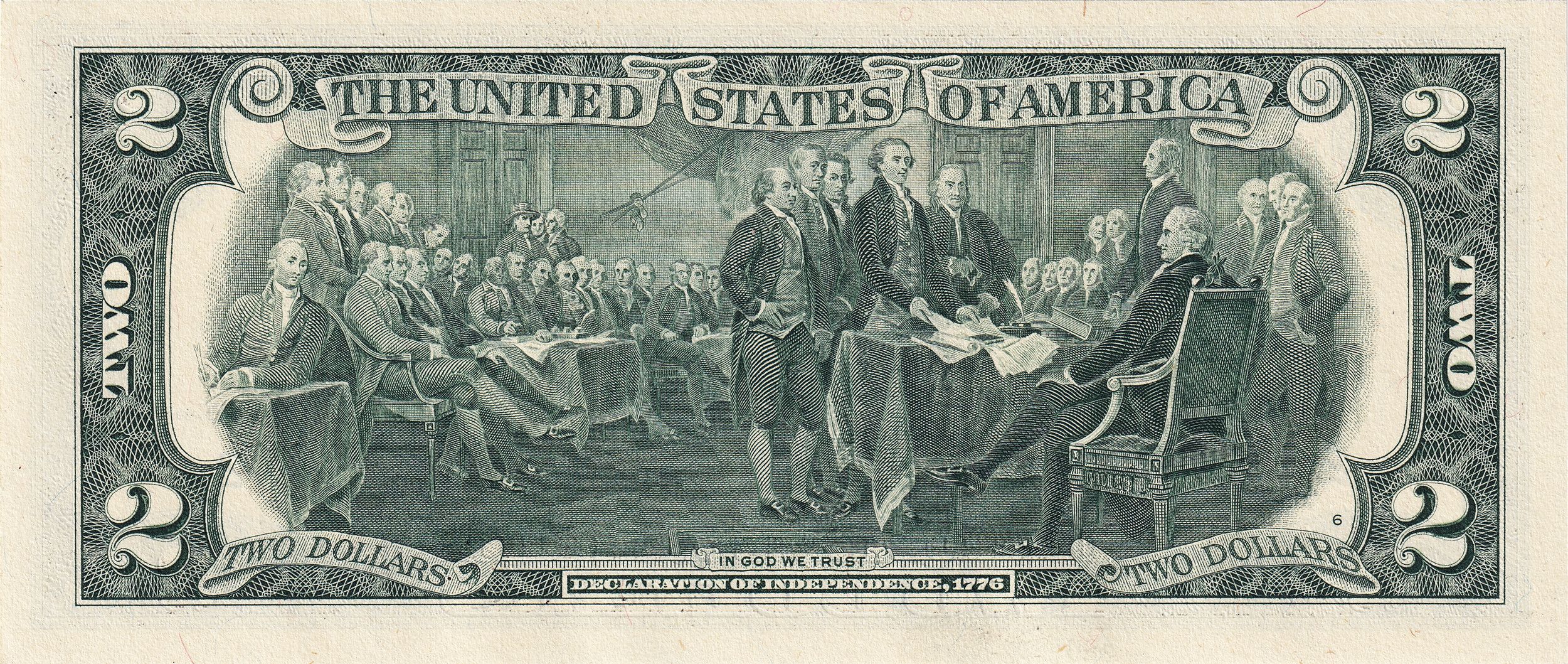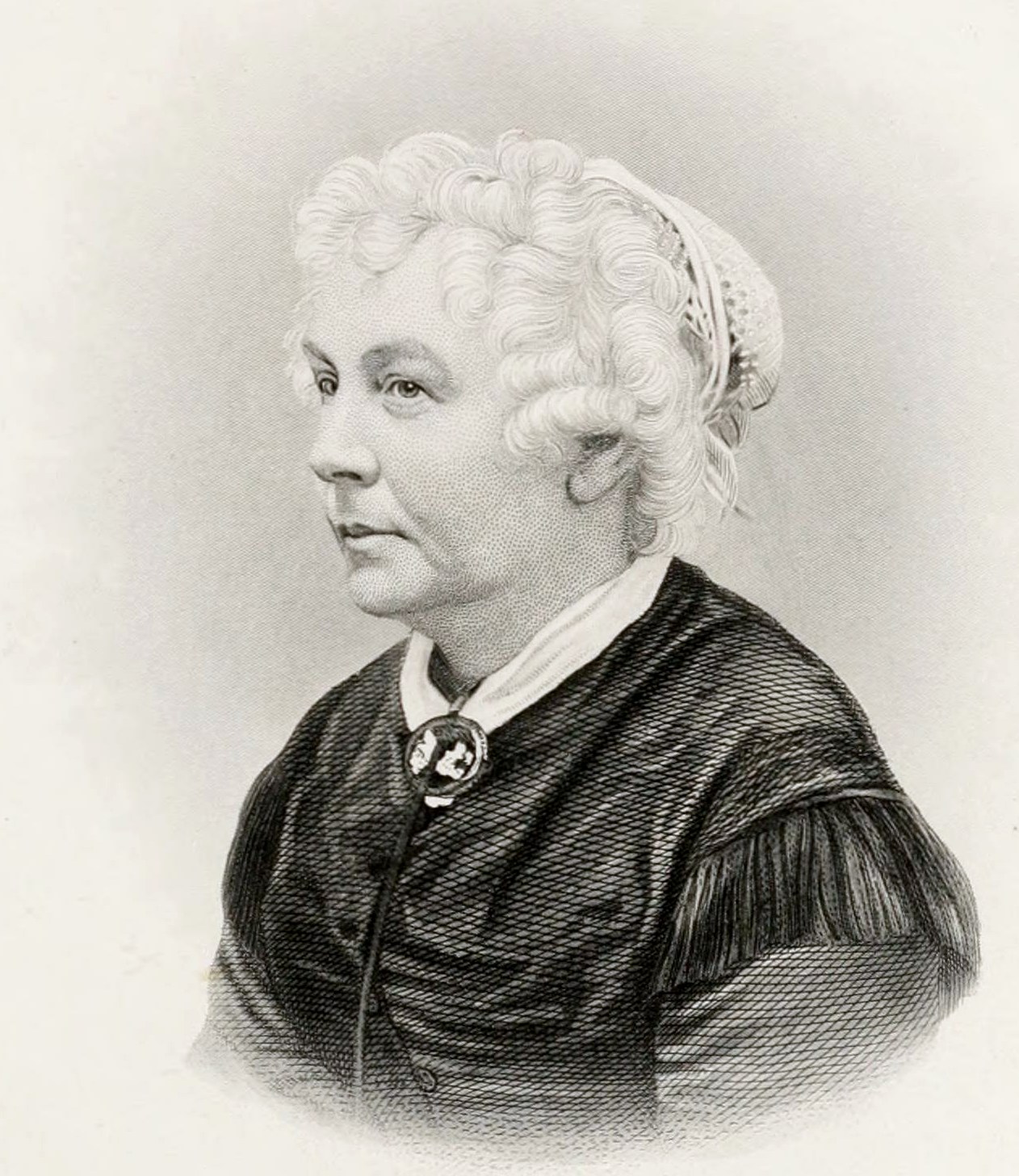
John Trumbull's Painting of a Drafting Committee Presenting
the Declaration of Independence to Congress.
This image is found on the back of the two dollar bill.
Topics on the Page
Overview of the Declaration
Primary Sources
Timelines
Multimedia Resources
Key Ideas in the Declaration
- John Locke's Influence
- Jefferson's Political Philosophy
- Mary Katherine Goddard and the Goddard Broadside
More Declarations of Independence in U.S. History
The Declaration in a Global Perspective
- Haitian Declaration of Independence (1804)
- New Zealand Declaration of Independence (1835)
- Declaration of the Democratic Republic of Vietnam (1945)
Focus Question: What ideas and events influenced the writing of the Declaration of Independence and Thomas Jefferson's political philosophy?
Overview of the Declaration
"The Declaration of Independence does not have the force of law; the Constitution establishes the shape of government, and the limits and boundaries of the freedom it protects. The Constitution does not specifically recognize equality in the way the Declaration does, except perhaps in the Reconstruction Amendments. . . The Declaration remains the outstanding example of the spirit, as opposed to the letter, of U.S. law."
Quoted in The Declaration: A Primary Sourcebook, Teaching American History Professional Development Project,
- Fall River Public Schools and Bristol Community College, p. 1
Declaration Resources Project, Harvard University
 Learning Plans
Learning Plans
Go here a lesson plan to create a simplified version of the Declaration of Independence
 Primary Sources
Primary Sources

Monticello Classroom Image Gallery
- Explore images of the Declaration of independence, maps explaining the Louisiana Purchase, portraits of Jefferson, and more!
- Can you find a primary source that really interests you and try to analyze it historically?
Timeline of Jefferson's Life
- From birth to death, learn about the important events in both Jefferson's private and public life
Timeline: The New Nation
- Highlights and summarizes key events from 1783-1815
- also does the same from before 1783 and all the way up to the present
 Multimedia & Interactive Websites:
Multimedia & Interactive Websites:
Click on Ages of Revolution: How Old Were They on July 4, 1776? to find out the ages of the key participants in the American Revolution on July 4,1776. More than one dozen of the signers of the Declaration were under 35 years old.
- BrainPop interactive Declaration of Independence Video
Thomas Jefferson and His Democracy: Crash Course U.S. History
WATCH: Liberty's Kids: The First Fourth of July
Thomas Jefferson for Kids
William Penn at age 22 (1666)

 Text of William Penn's Concessions and Agreements of the Proprietors, Freeholders, and Inhabitants of the Province of West New Jersey, 1677.
Text of William Penn's Concessions and Agreements of the Proprietors, Freeholders, and Inhabitants of the Province of West New Jersey, 1677.
This document established a representative democracy with freedom of religion, assembly and trial by jury 100 years before the Declaration of Independence.
See also the Founding of the Quaker Colony of West Jersey
- Stated that men have "inalienable rights" that the founding fathers felt had been violated by Great Britain
- Believed that everyone "endowed by their Creator" had the right for "life liberty and the pursuit of happiness"
- Stated that the people have a right to cut ties with a government that they feel is unjust
- Stated that the colonists had endured sufficient amounts of intolerable acts that deemed their separation from its mother country justifiable
- Listed the acts and laws that Great Britain had passed that many colonists disagreed with
- Stated that the British should not be surprised by the colonies' announcement because they had been warned numerous times that their acts were intolerable
John Locke and influences on the Declaration of Independence
Locke's Political Philosophy
Some argue that the declaration was in some ways inspired by several great thinkers who had considered republicanism before the creation of the Declaration
- One of these thinkers was John Locke, who believed in "social contract" or the right the people have to govern in order to maintain social order - includes giving up what he believed to be excessive rights
- Locke wrote that the people could dismiss a government that did not provide support for their natural and social rights: life, liberty, and property - property was a right derived from labor
- His ideas were strongly influential on the Declaration; Jefferson slightly edited Locke's natural rights theory to life, liberty, and the pursuit of happiness because many colonists did not own property
- For info on others who influenced the founding of the American states, check out this video on Jean-Jacque Rousseau.
Political Philosophy of Thomas Jefferson
- Believed in limited powers on the federal level
- Wanted to ensure that small, local governments were capable of keeping the federal government accountable
- His political philosophies on restraining the federal government were greatly rooted in the fears that many colonists had following their experiences with Great Britain's controlling governing strategies. Many colonists, and even early Americans, remained fearful that the United States would become a monarchical society mirroring England's
- Believed that all men should be educated and politically informed
- Imagined a smaller groups of educated elites ruling their local governments
For more on Thomas Jefferson and slavery, link to
For more information about the Declaration and Thomas Jefferson, check out Hans Eicholz book Harmonizing Sentiments
Early Attempts at Abolishing Slavery
- How Jefferson ironically owned slaves, tensions leading to the Civil War, and more!
Check out TED-Ed's video on the misconceptions surrounding the Declaration of Independence
If teachers would like to supplement their lessons on the Second Continental Congress and the Declaration of Independence, the HBO miniseries John Adams contextualizes the period quite well (even if some of the scenes are somewhat historically inaccurate).
In any event, the Declaration of Independence resolution and subsequent proclamation scene showcased its importance in changing the mission of the Revolution
 The Goddard Broadside
The Goddard Broadside
Mary Katharine Goddard printed the names of the signers of the Declaration of Independence in January 1777

To learn about Mary Katherine Goddard, printer and postmaster to the Second Continental Congress and the one woman whose name appears on the Declaration of Independence, link here to the Declaration Resources Project.
For more information about the women behind the signers of the Declaration.

Declaration of Sentiments (1848)

To read the Declaration of Sentiments, link here.
The Declaration of Independence was used as a model by Elizabeth Cady Stanton to forthrightly demand that the rights of women as right-bearing individuals be acknowledged and respected by society in the Declaration of Sentiments.

Link here for a two-day lesson plan on Seneca Falls and how women in the 19th century manipulated the Declaration of Independence to gain more rights for women!
Seneca Falls Declaration, from Teaching American History Project, Windham (Connecticut) Public Schools
Seneca Falls Convention, National Women's History Museum
African American women were exclude from the suffragette movement. Learn about African American leaders and in the fight for women's suffrage by following the link below.
How History Classes on the Women's Suffrage Movement Leave Out the Work of Black Voting Rights Activists, Time Magazine
 To learn more about the achievements of Elizabeth Cady Stanton, link here.
To learn more about the achievements of Elizabeth Cady Stanton, link here.
Contemporary Depictions of the Events of the Declaration of Independence

1776 Production Photo
Sushma Saha, Sara Porkalob, Mehry Eslaminia, Gisela Adisa, Crystal Lucas-Perry,
Elizabeth A. Davis, Becca Ayers, Brooke Simpson, and Oneika Phillips in 1776.
Photo: Evan Zimmerman for Murphy Made
During the Summer of 2022, a revival of the beloved musical 1776 ran at the American Repertory Theatre in Cambridge Massachusetts. This revival reimagined the story of John Adams and his attempts to persuade the Constitutional Congress to vote for American Independence and sign the Declaration. With a “cast that reflects multiple representations of race, gender, and ethnicity”, this production forces us to grapple with the questions: how much were they willing to compromise in the pursuit of freedom? And who does that freedom belong to?
Click on the links below to watch the trailer, view the production site, and listen to the Co-director explain the goals and achievements of ART’s 1776.
Making a Musical: 1776 Co-director Diane Paulus
1776: The Musical Trailer
1776 | A.R.T.
United Steelworkers Declaration of Independence (1936)
We Are Americans! The Homestead Workers Issue a Declaration of Independence by 1936
 |
| Indonesian Stamp, 1946 |
Universal Declaration of Human Rights
Declarations of Independence Around the World
The Declaration of Independence in a World Perspective
- More than half of the countries now represented at the United Nations have a founding document that can be called a declaration of independence
There have been three major periods of declaring independence:
- the years from 1776 to the Revolutions of 1848 in Europe;
- the immediate aftermath of the First World War and the breakup of the Ottoman and Austro-Hungarian Empires;
- and the decades from to 1945 to 1979, when 70 newly independent states emerged from the wreckage of the European colonial empires.
Haiti
Haitian Declaration of Independence (1804)
New Zealand
New Zealand Declaration of Independence (1835)
- Signed by a number of native Maori chief, this document proclaimed sovereign independence of New Zealand
- Background info on its importance
Vietnam
Declaration of Independence of the Democratic Republic of Vietnam (1945)
India
Indian Independence Act (1947)
Works Cited:
Declaration of Independence. Retrieved April 5, 2007, from The National Archives Experience Web site: http://www.archives.gov/national-archives-experience/charters/declaration.html
John Locke. Retrieved April 5, 2007, from Stanford Encyclopedia of Philosophy Web site: http://plato.stanford.edu/entries/locke/
Thomas Jefferson. Retrieved April 5, 2007, from The White House Web site: http://www.whitehouse.gov/history/presidents/tj3.html
Comments (0)
You don't have permission to comment on this page.